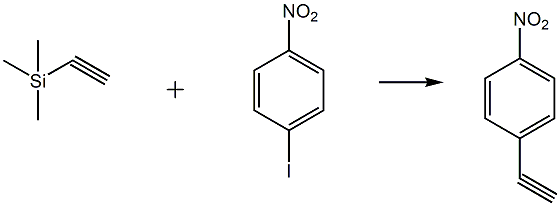Background and overview[1]
4-Nitrophenylacetylene is an organic intermediate that can be prepared from 1-iodo-4-nitrobenzene in two steps.

Preparation[1]
Step 1 Preparation of [4-(nitrophenyl)ethynyl]trimethylsilane (S7g)
To 1-iodo-4-nitrobenzene (S6) (1.00 g, 4.02 mmol), Pd(PPh3)2Cl2 (84.3 mg, 0.120 mmol), CuI (45.7) and Et3N (2.24 mg, 16.4 mmol) Add (trimethylsilyl)acetylene (560 mg, 4.06 mmol) to 6.8 ml of DMF solution (S5). After stirring at 50°C for 1 hour, the reaction mixture was diluted with AcOEt and H2O. The organic layer was washed 3 times with water, washed with brine, dried over Na2SO4, filtered, and concentrated under reduced pressure. The residue was purified by silica gel flash column chromatography (hexane/AcOEt = 2:1) to obtain [4-(nitrophenyl)ethynyl]-trimethylsilane S7g. Yellow solid, 730 mg, 3.33 mmol, 83%. 1 H NMR (400 MHz, CDCl3) δ 8.17 (d, J = 8.8 Hz, 2H), 7.59 (d, J = 8.8 Hz, 2H), 0.28 (s, 9H).
Step 2 4-Nitrophenylacetylene (8g)
To a solution of [4-(nitrophenyl)ethynyl]trimethylsilane S7g (69.9mg, 0.318mmol) in THF (0.43mL) at 0°C, add TBAF (1.0M solution in THF, 0.38mL, 38μmol). After stirring for 15 minutes, the reaction was quenched with saturated aqueous NaHCO3 solution, and the resulting mixture was extracted three times with Et2O. The combined organic extracts were washed with brine, dried over Na2SO4, filtered, and concentrated under reduced pressure. The residue was purified by silica gel flash column chromatography (hexane/AcOEt=1:10) and gel permeation chromatography to obtain 8 g of alkyne. White solid, 37.5 mg, 0.255 mmol, 80%. 1HNMR (400MHz, CDCl3) δ8.20 (d, J=9.0Hz, 2H), 7.64 (d, J=9.0Hz, 2H), 3.36 (1H, s).
Main reference materials
[1]From Organic Letters, 16(18), 4948-4951; 201

 微信扫一扫打赏
微信扫一扫打赏

